

Max Davies
2026 GWM Haval Jolion review
25 Minutes Ago
Honda, Volkswagen, and Mazda have taken their hatchbacks upmarket, at least when it comes to price. Which has done it most convincingly?

Contributor
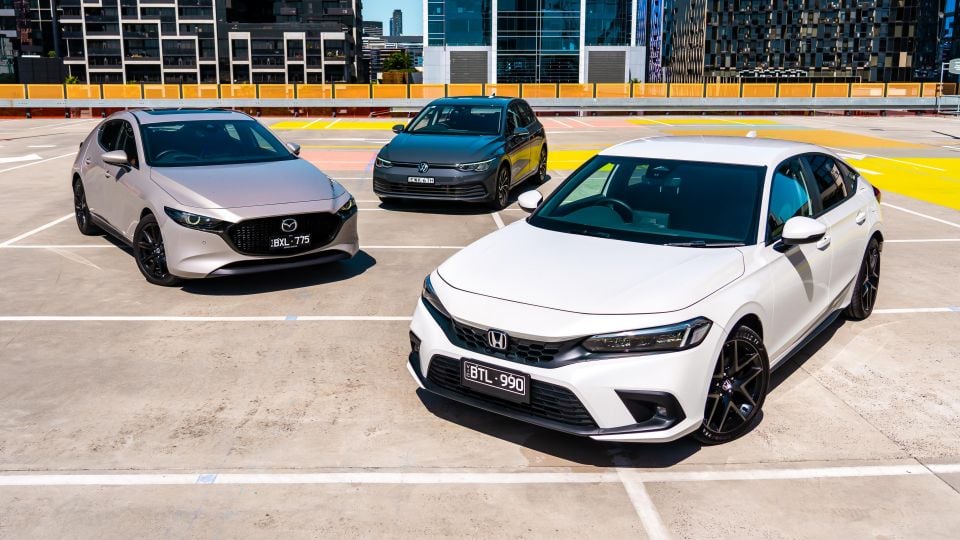

Contributor
The Honda Civic, Volkswagen Golf, and Mazda 3 are small car staples in Australia, but they’re not the bargains they once were.
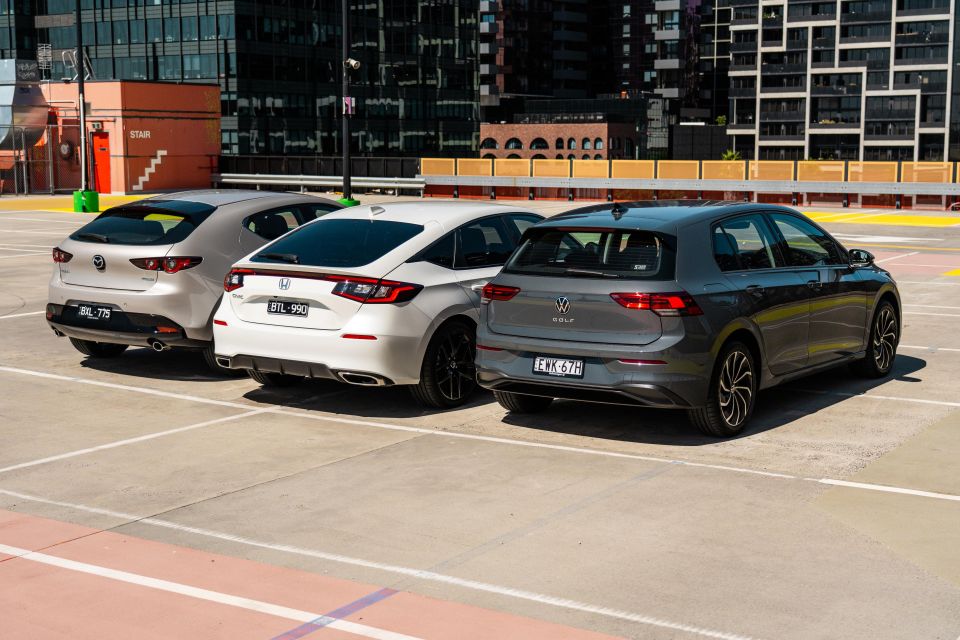
Once upon a time you could get a generously equipped hatchback for less than $35,000 drive-away; the cheapest member of the trio on test here has a drive-away price $10,000 higher than that.
Honda in Australia doesn’t offer a basic Civic anymore, and the car itself isn’t that small. It’s morphed into a well-equipped family hatchback with a boot that’d make a Camry blush, with just a sprinkling of sportiness stuffed into its slinky-looking shell. Whisper it, but you could almost liken it to an Accord Euro.
Volkswagen has been more gradual with its evolution of the Golf formula.
The eighth-generation Golf you see here builds on the foundation laid down by the seventh-gen car which, in turn, was an evolution of the sixth-gen car which… you get the idea. It’s higher-tech inside than ever, for better or worse.
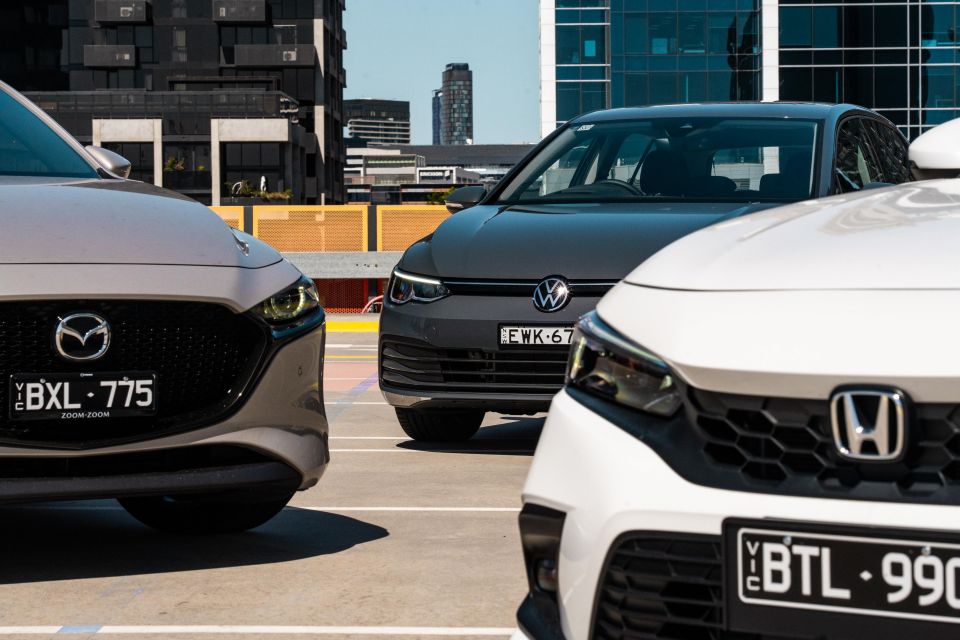
Finally, the Mazda 3. It’s the best-selling member of our trio, but even it departs from the recipe laid down by its wildly successful predecessors.
Practicality be damned, the latest Mazda 3 is more about zoomzoom than room room. With the CX-30 now on hand to look after buyers who need to use the back seats regularly, the design team in Hiroshima has turned the 3 into a sporty little hatch for young couples or empty nesters.
Which of these more grown up, expensive hatchbacks is most deserving of your hard-earned?
The Honda Civic made waves with its price at launch, but it shapes up favourably against the pair of rivals it’s battling here.

It has a no-haggle, drive-away price of $47,200 in Australia for the VTi LX under Honda’s new agency sales model.
The Golf Life is in short supply at the moment, but it still shows up on the Volkswagen Australia stock checker with a drive-away price of $47,120 using a Melbourne postcode. It’s worth noting the Life is a mid-spec car, unlike the range-topping Mazda and Honda.
Speaking of the Mazda, it’s the most affordable of the three cars on test here in G25 Astina guise with a drive-away price of $44,885 using a Melbourne postcode according to the brand’s website.
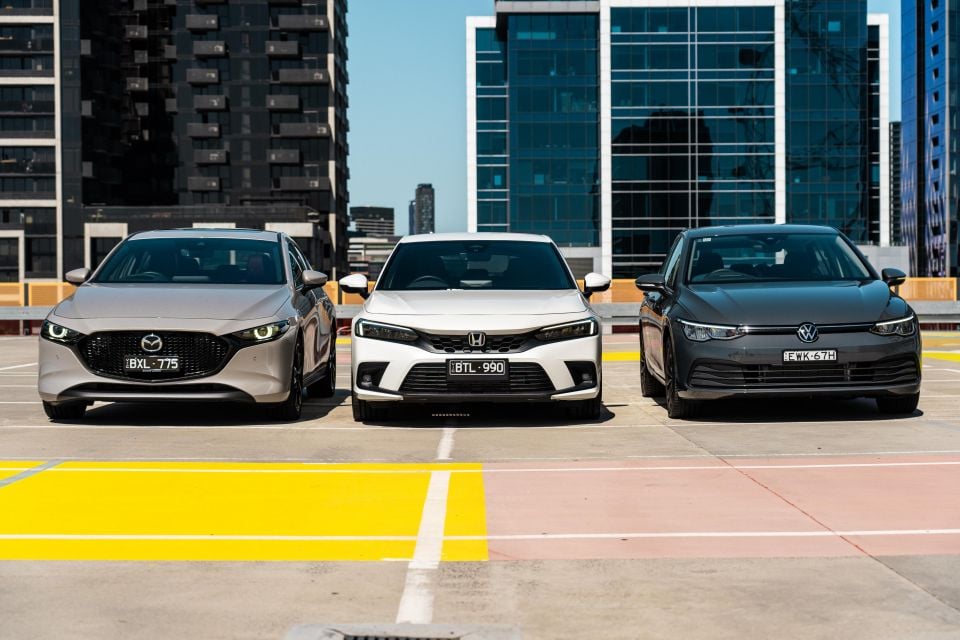
Standard equipment common to all three cars includes:
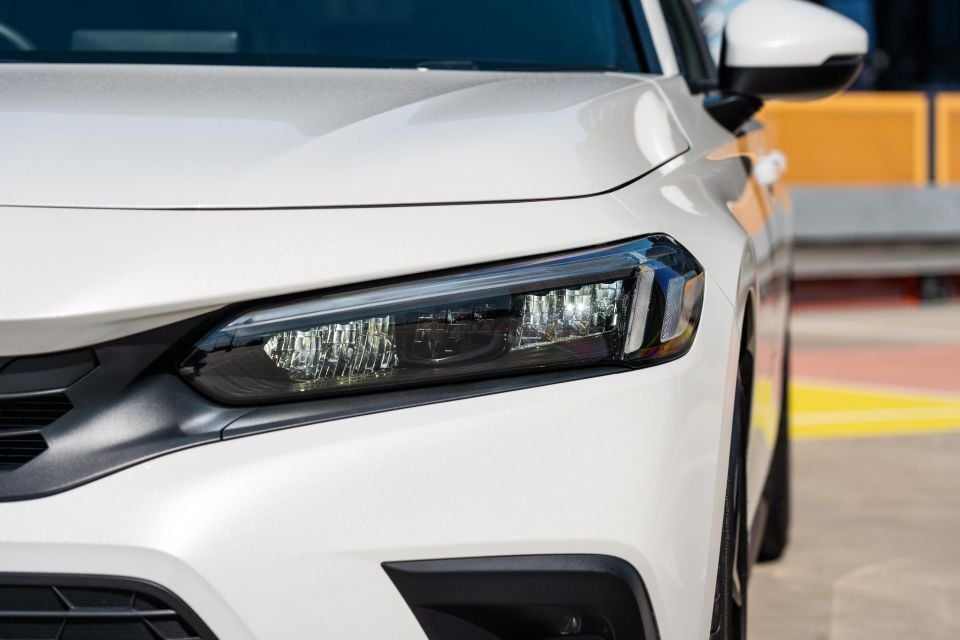

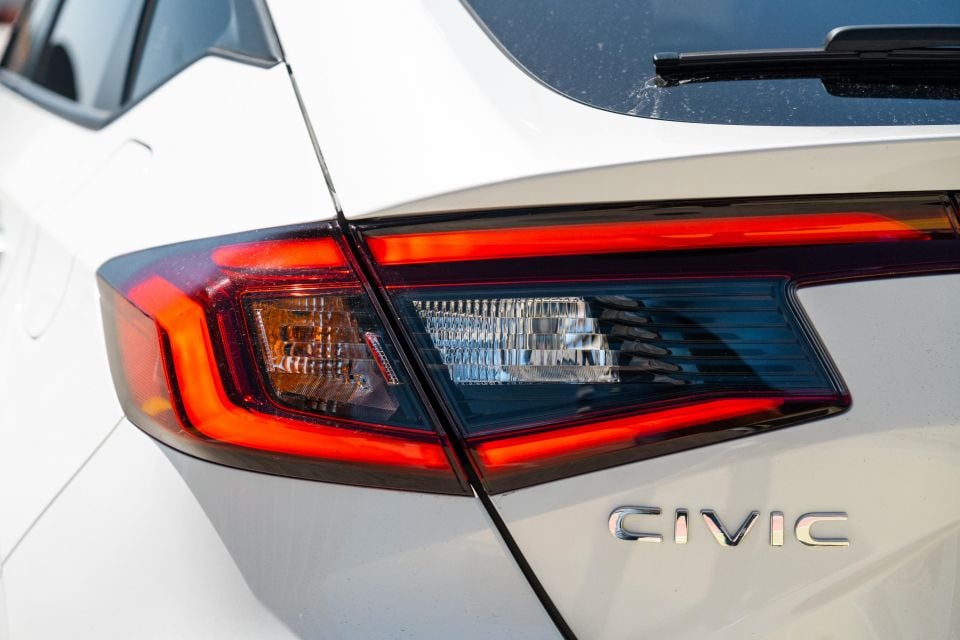

Specific equipment on the Honda includes:
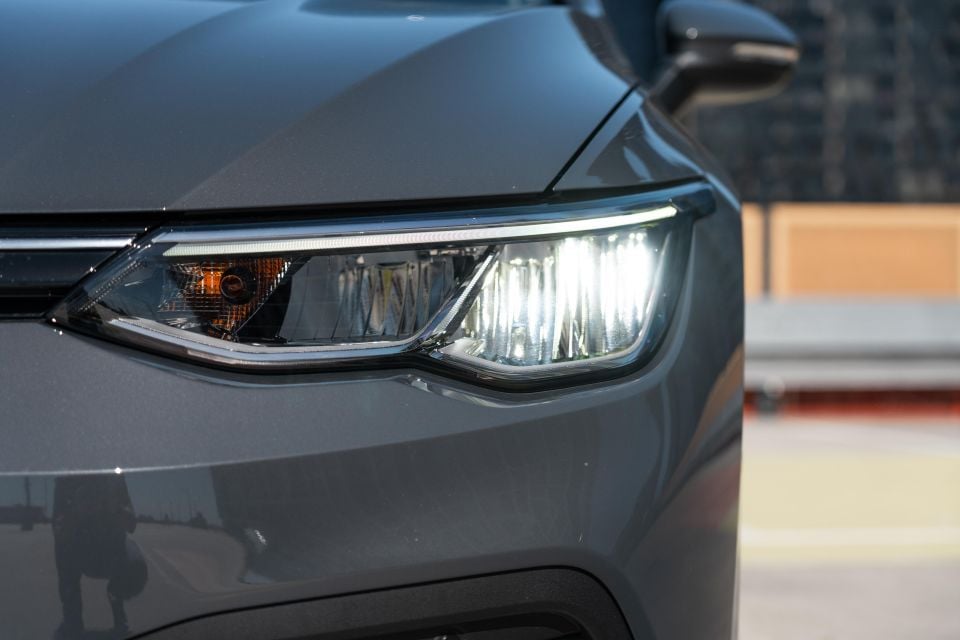
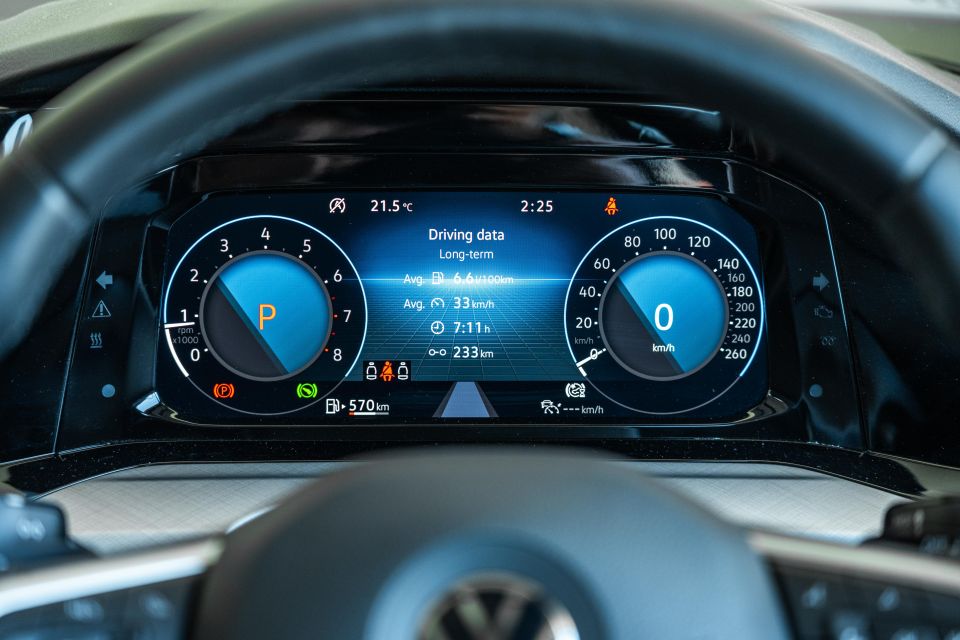
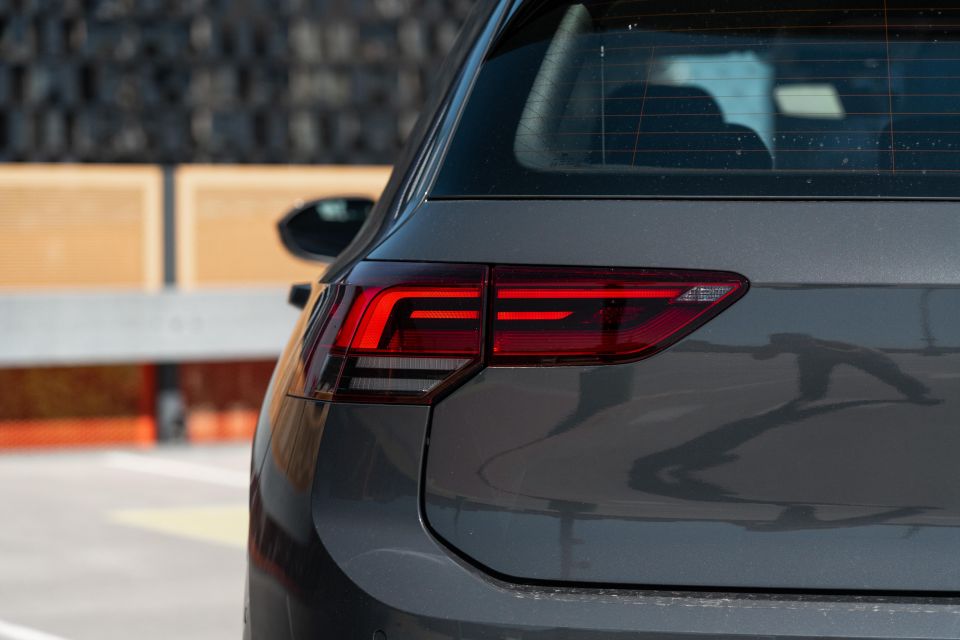
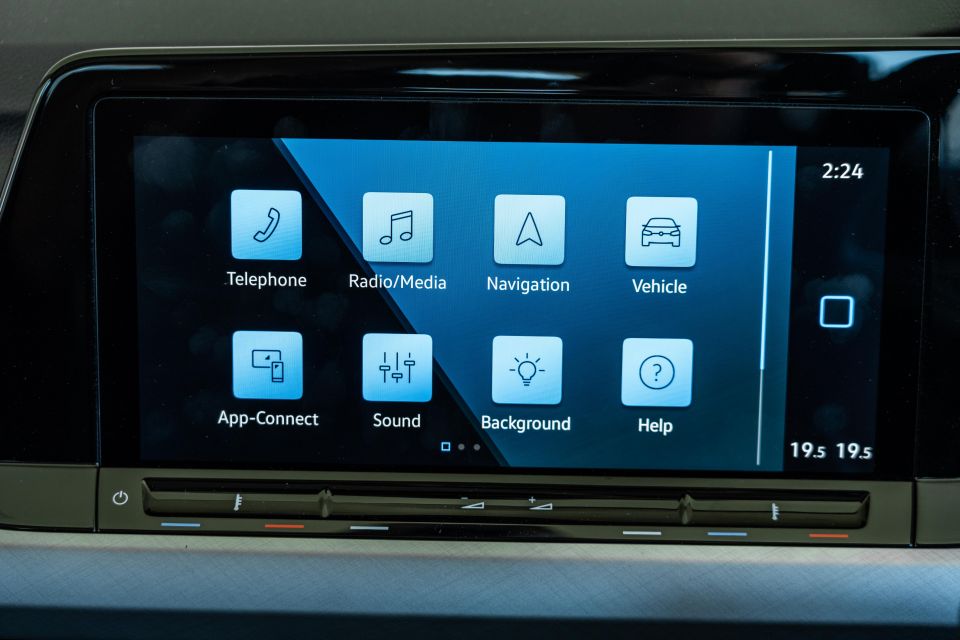
Specific equipment on the Golf includes:
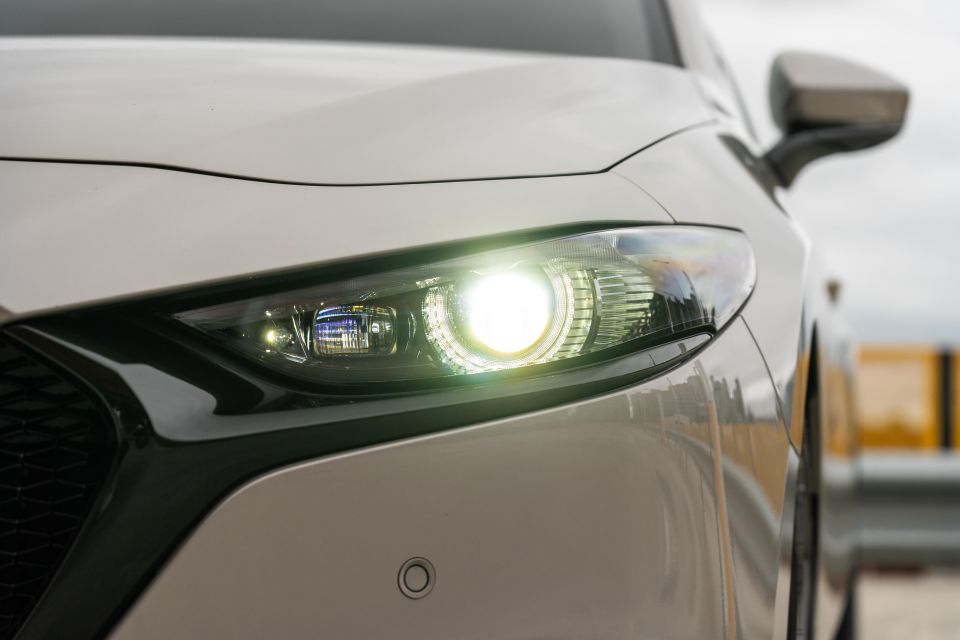
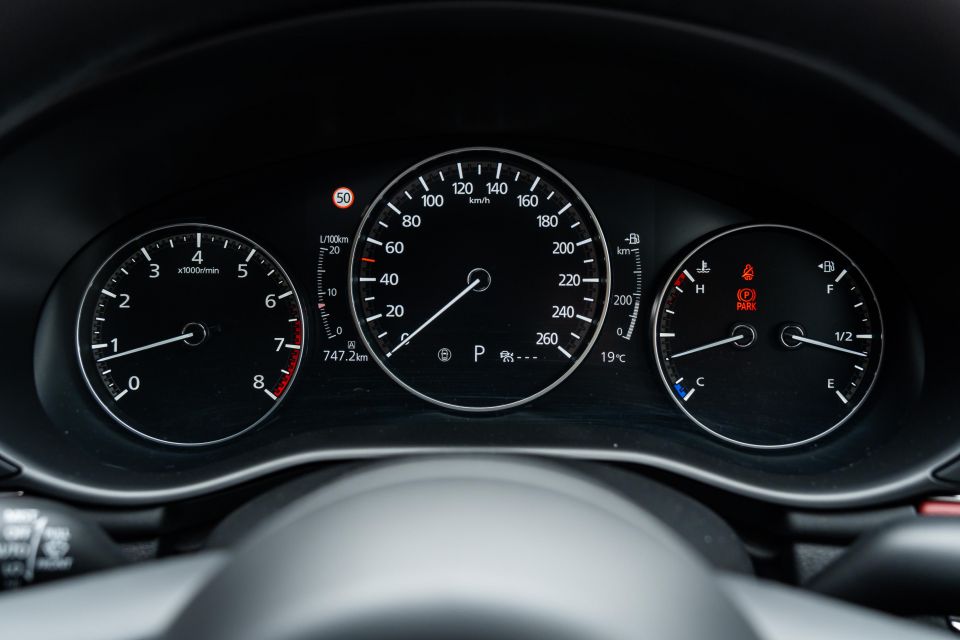

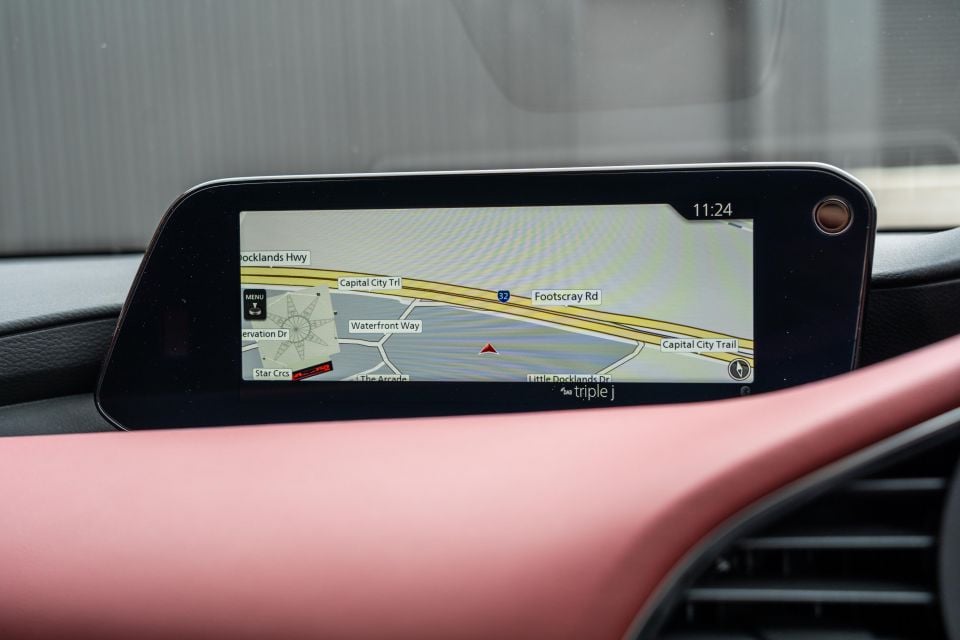
Specific equipment on the Mazda 3 includes:
Honda Civic
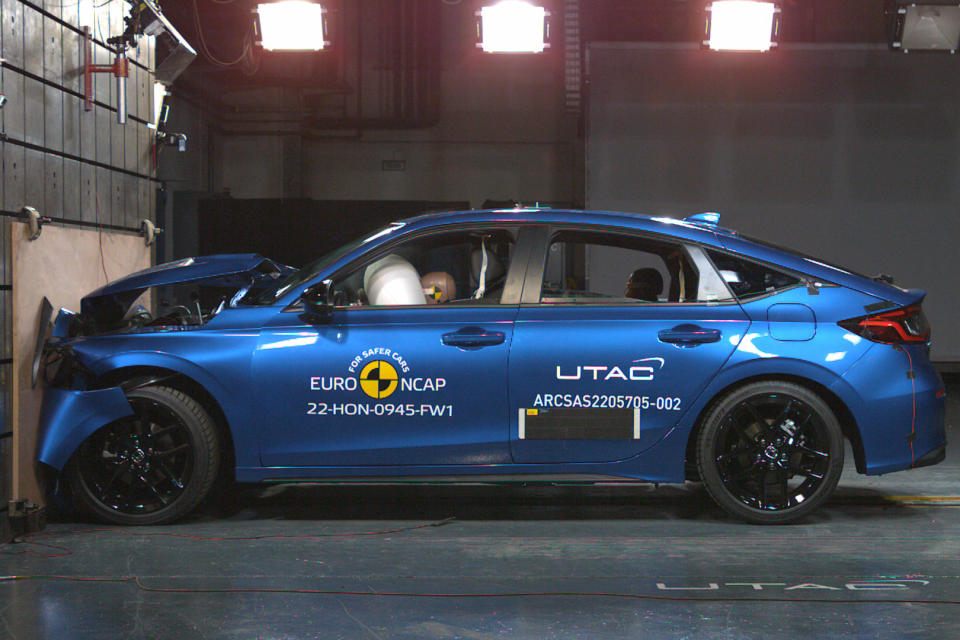
The Honda Civic has yet to have its five-star Euro NCAP rating adopted by ANCAP.
In Euro NCAP testing carried out during 2022 it scored 89 per cent for adult occupant protection, 87 per cent for child occupant protection, 82 per cent for vulnerable road user protection, and 83 per cent for safety assist.
It features eight airbags.
Volkswagen Golf
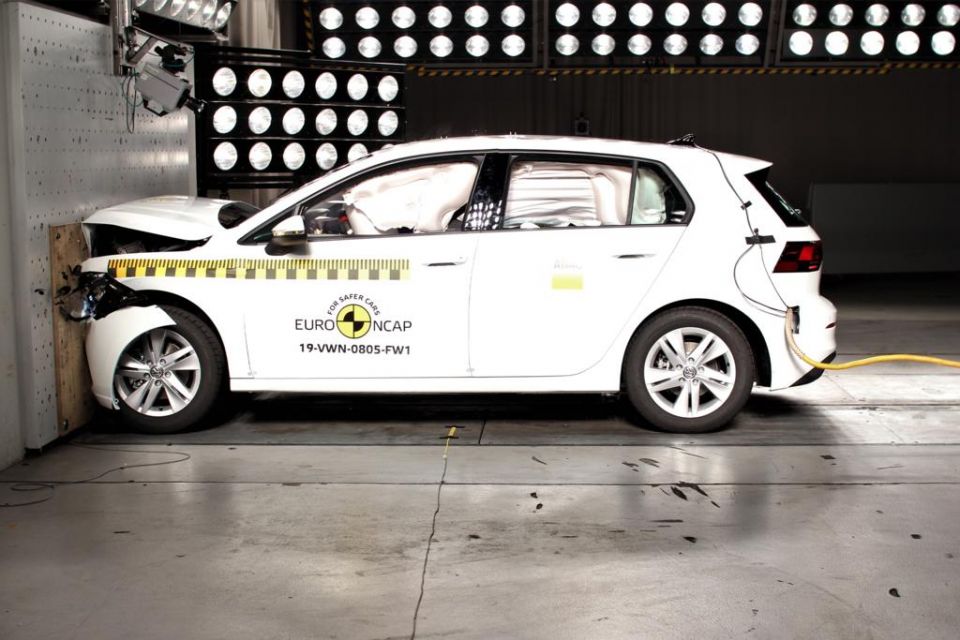
The Volkswagen Golf has a five-star ANCAP safety rating based on testing carried out by Euro NCAP in 2019.
It scored 95 per cent for adult occupant protection, 89 per cent for child occupant protection, 76 per cent for vulnerable road user protection, and 80 per cent for safety assist. It features eight airbags.
Mazda 3
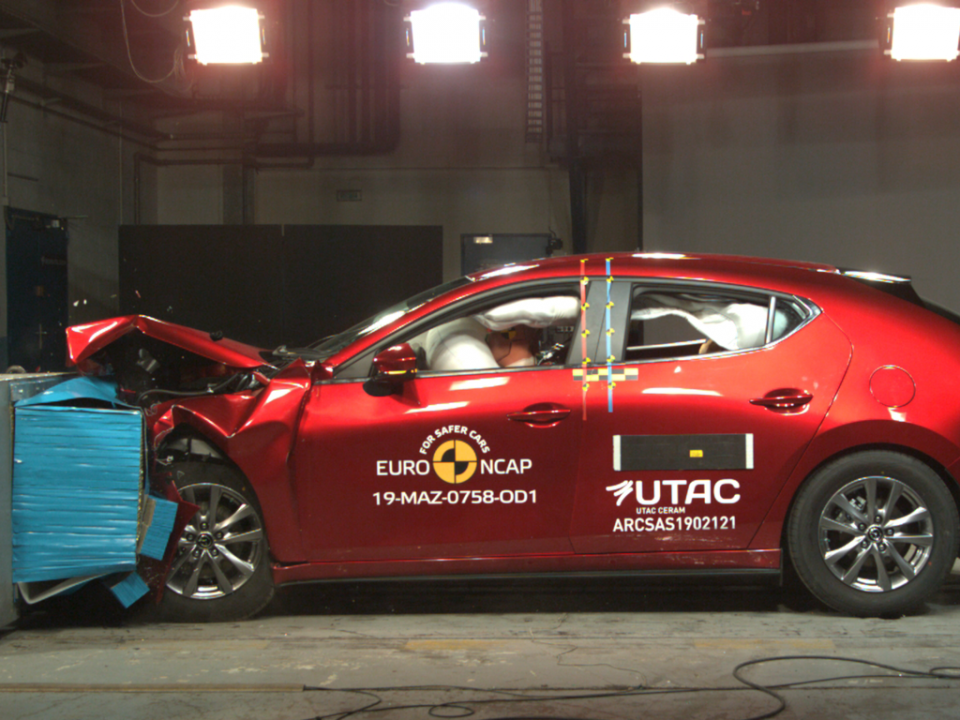
The Mazda 3 wears a five-star ANCAP safety rating based on testing carried out by Euro NCAP in 2019.
It scored 98 per cent for adult occupant protection, 89 per cent for child occupant protection, 81 per cent for vulnerable road user protection, and 76 per cent for safety assist. It features seven airbags.
Standard safety equipment on all three cars includes:
The Mazda 3 features exclusively:
TheVolkswagen Golf features exclusively:
The Honda Civic has no safety features unique to its rivals.
Honda Civic

The last Civic was spacious but uninspiring inside. The new one is still spacious, but feels like more love has been lavished on it behind the wheel.
It isn’t quite as pretty to look at or luxurious to touch as the Mazda, but little details like the click of the knurled climate dials and the metal-effect lattice across the dashboard elevate it above the slightly dour Golf.
The seats are plush, and the driving position is excellent. You can get down low, and the leather-trimmed steering wheel comes straight out from the dashboard rather than on an awkward angle. It feels quite sporty compared to the Golf and Mazda.
All the major controls are easy to reach, and vision out the windscreen is excellent. The sloping roofline means over-the-shoulder visibility isn’t perfect, but it’s better than the Mazda and its huge, vision-destroying C-pillar.
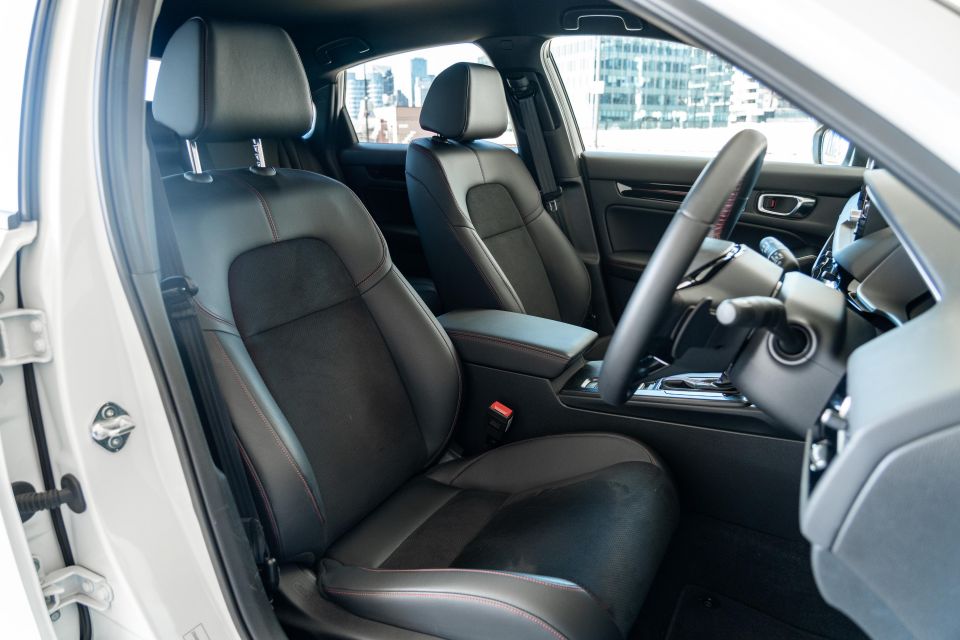

There’s less storage than in the last Civic, but the dual cupholders, wireless phone charger, and deep central bin offer more than enough space to store your stuff. It’s more usable than before, and the cushy central armrest is nicer than the hard, small spot previously offered.
Honda has traditionally struggled with its infotainment tech, but the system in the new Civic is a huge step forward.
It’s modern to look at, with crisp graphics and simple, slick menus. The maps finally look like an OEM product rather than an aftermarket system, although the wireless smartphone mirroring means you can easily sidestep the inbuilt software anyway.
Even the reversing camera is sharp and bright, unlike the foggy unit from the last car. Over-the-air updates mean the system can be updated throughout its life, too.
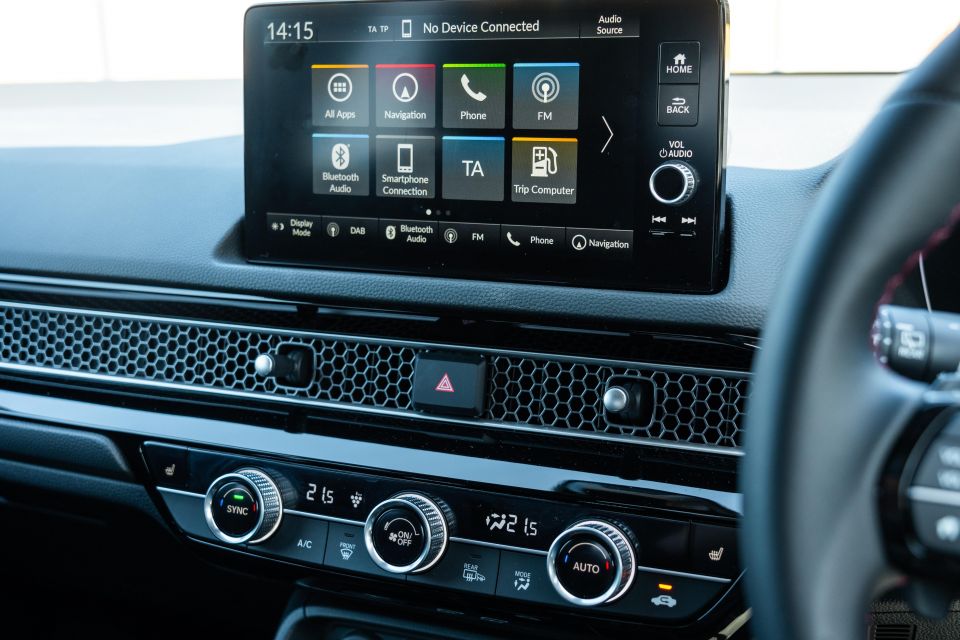
Where expert car reviews meet expert car buying – CarExpert gives you trusted advice, personalised service and real savings on your next new car.
Honda has stuck with proper climate controls, with dials and buttons below the touchscreen that, like those in the Mazda, are so much better than the finicky touch controls in the Volkswagen.
It’s a shame Honda (like Mazda) has gone with USB-A ports rather than the faster, more modern USB-C ports rolling out elsewhere on the Civic – or one of each, as is becoming common.
The driver’s display is fine. Honda hasn’t fitted the fully digital setup offered in Japan, instead pairing an analogue speedo with a 7.0-inch screen that essentially mimics an analogue rev counter with trip computer functions inside it.
With elegant fonts and an easy-to-read design it’s similar to the one in the 3, but can’t come close to matching the Golf’s digital dials for cool factor.
Rear legroom has never been a Civic problem, and the longer wheelbase on this particular model means that’s still the case.


At 4549mm long, 1414mm tall and 1800mm wide it’s just shy of 300mm longer than the Golf, although it’s only 11mm wider – and that plays out in the form of a spacious, usable second row. It’s also close to just shy of 100mm longer than the Mazda.
That pays off with the best legroom, although the Golf has it covered (marginally) for headroom. It’s worth noting the central seat is quite raised relative to the outboard ones, meaning it’s a spot best reserved for short trips.
Rear amenities include a fold-down central armrest, rear vents, but no USB ports of any form.
Claimed boot space is 404 litres but there’s another 45 litres of underfloor storage, expanding the gross space to 449 litres. It’s the most useful space on offer in any of the cars here, with a wide opening and limited loading lip.
Volkswagen Golf
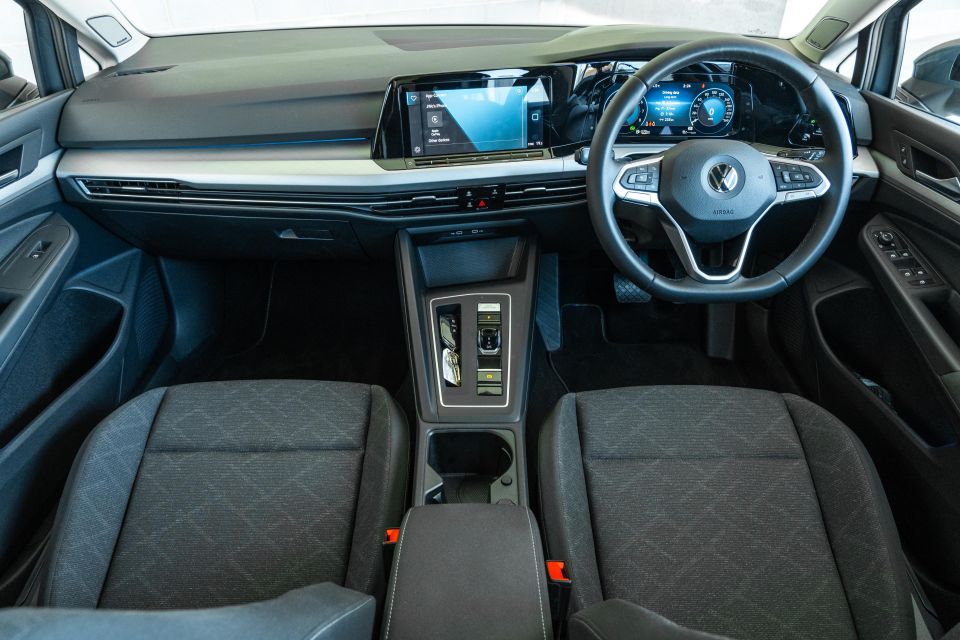
You probably know the Golf isn’t quite as user-friendly as it once was behind the wheel.
Buttons are few and far between, and two big screens with beautifully-rendered, colourful graphics are standard across the range. It’s comfortably the most modern-looking cabin of the trio.
Before we get into complaining, the Golf deserves credit for the things it does really well.
The driving position is a strong point. The driver’s seat drops down low and slides back far enough to accomodate long-legged pilots, the steering wheel feels great in the hands, and vision out the heavily-reclined windscreen is good.
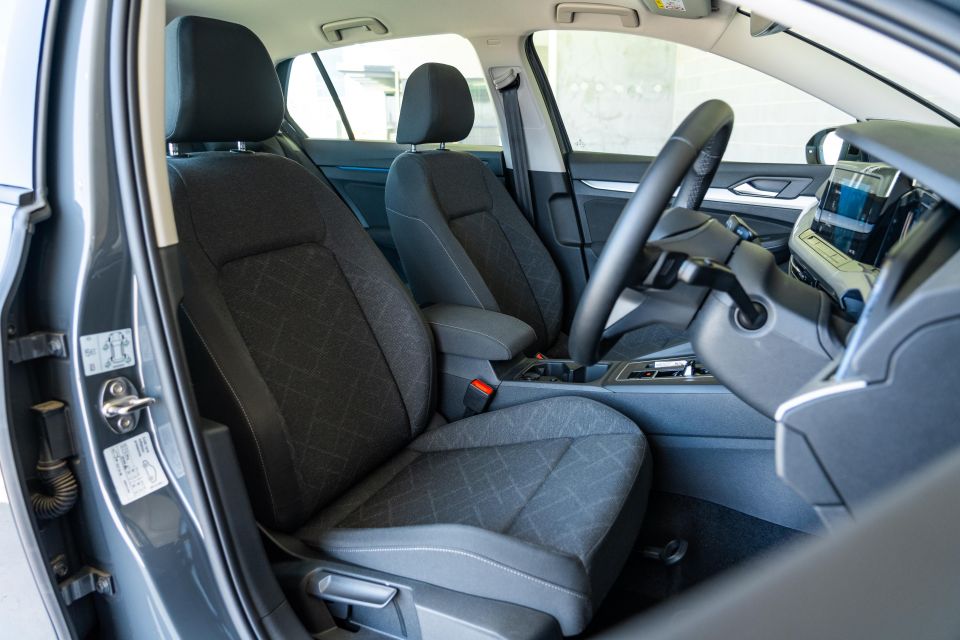

The front doors are topped with soft-touch trim, the door pockets are felt-lined, and the gear selector clicks positively into place, all of which are things we’ve come to expect of Volkswagen small cars.
It’s very demure alongside the Honda and Mazda, though. The former has suede/leather trimmed seats and interesting, retro patterns on the dashboard, while the latter features lush-looking red and black leather inside.
The Golf has cloth seats with manual adjustment and no heating, and it’s generally less interesting to look at.
As for the technology? It’s a mixed bag. The driver’s display is excellent, with crisp graphics and just the right amount of information. It’s the most sophisticated of the three here, and sets the standard in the segment more broadly.

In eliminating buttons though, Volkswagen has also steepened the learning curve involved in the simplest tasks. You need to press a gloss black touch button on the dash and fiddle with the touchscreen just to change the fan speed, for example, which means you lose your navigation or media display.
It means more time with your eyes off the road, and more fingerprints on the screen and its gloss black surround, even if what you want to do should be simple.
Familiarity helps, but there’s no getting around the fact things that used to be easy are now harder. That’s not good enough in what’s meant to be an evolved take on the hatchback formula.
At least the graphics are clean, the responses sharp, and the customisation options nearly endless. The bones of a good system are there, but they’re hidden beneath a frustrating layer of user unfriendliness. It’s exacerbated by the fact the Honda’s system, although not quite as flashy to look at, majors on usability.
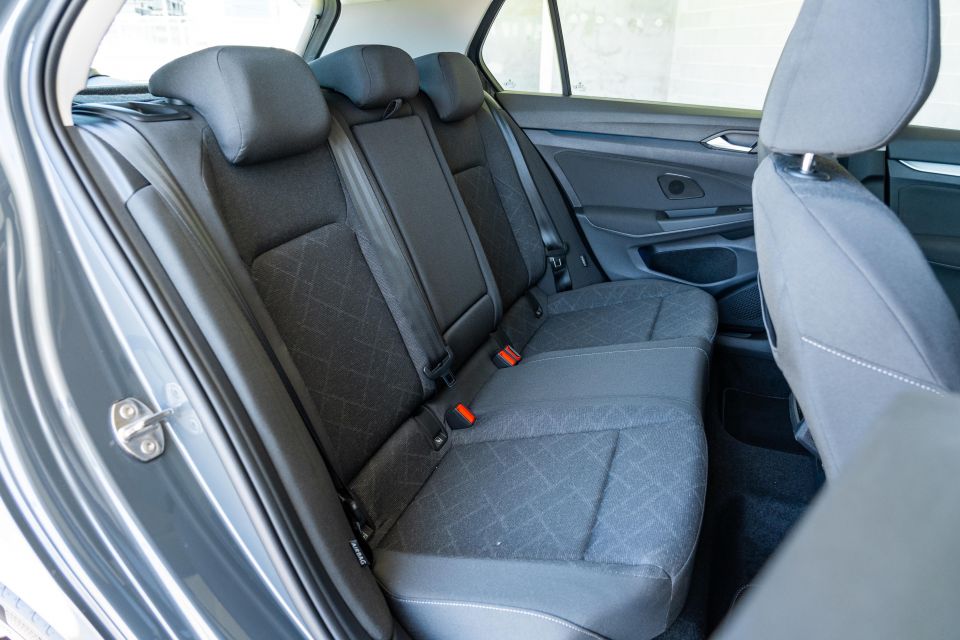
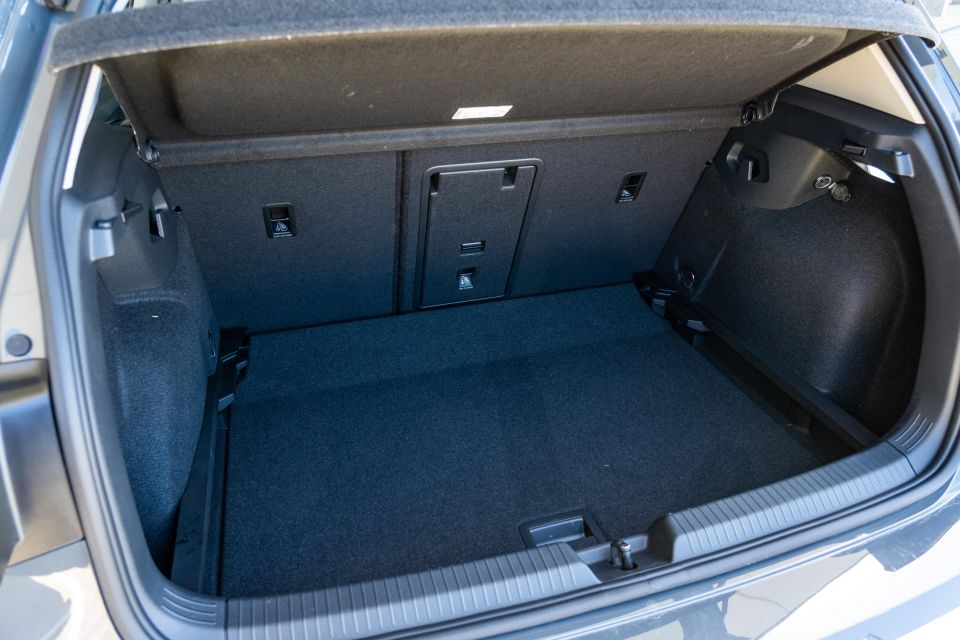
Volkswagen is the only brand of the three to offer more modern USB-C ports, and has two for both front and rear occupants.
Rear seat passengers are treated to decent legroom and headroom, with space for average-sized adults behind average-sized adults. Not only are there vents, the climate control pod allows rear passengers to set their own temperature.
Legroom falls short of what’s on offer in the Honda, but has the Mazda comfortably covered. Headroom is best of the three, and the conventional window line means it’s a light, bright space to sit.
Boot space is 374L with the rear seats in place, and 1230L with them folded. The space itself is broad and practical, and there’s no major loading lip when you pop the boot using the Volkswagen badge.
Mazda 3
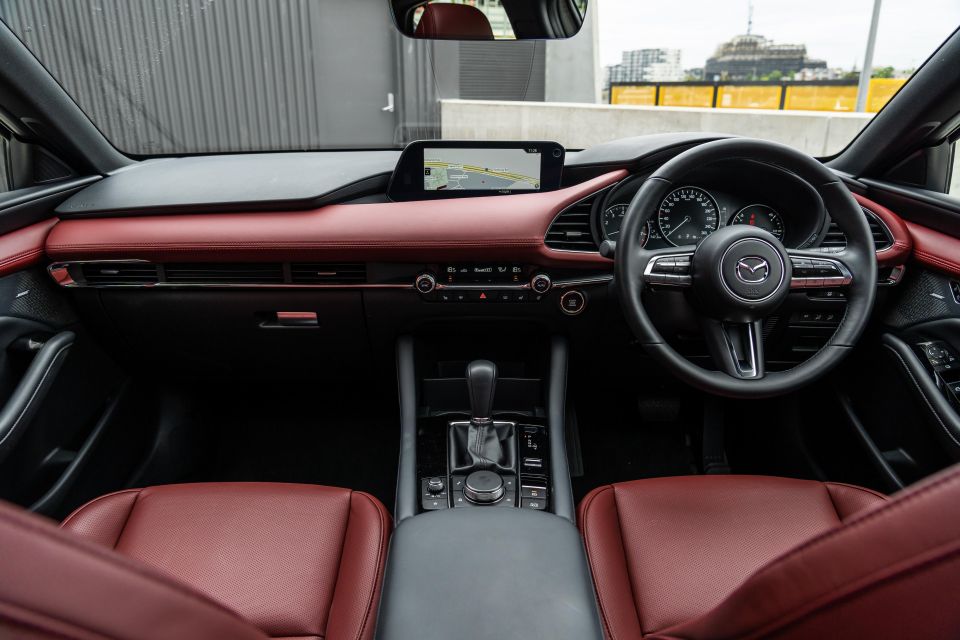
With a classic design and rich, red leather trim, the Mazda 3 is a unique alternative to the Honda and Volkswagen.
Mazda hasn’t been sucked into the latest industry trend for bigger screens and fewer buttons.
Even newer cars like the CX-60 and CX-90 have touchscreens that are integrated into their dashboards rather than dominating them, and the 3 (and related CX-30) is even more classical.
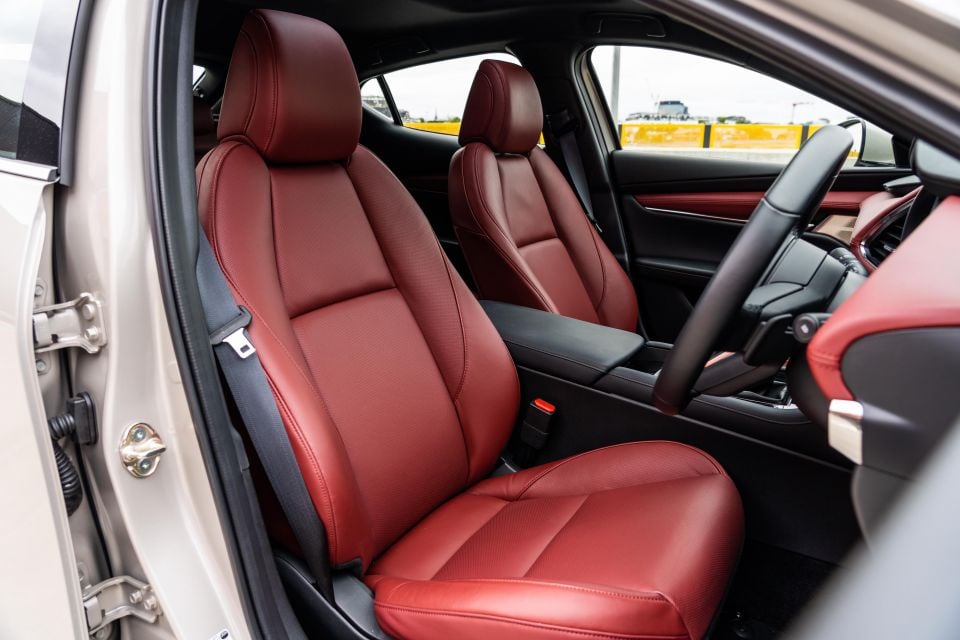



Want to change the temperature or fan speed? You get knurled-effect dials that make a satisfying click when you turn them, and buttons remove the need to dive through touchscreens or menus. Even alongside the more button-heavy Honda it feels like a quality item.
The old-fashioned way giveth, but it also taketh away. The screen in the 3 does look a bit small (and distant) relative to its rivals, and the fact it’s not a touchscreen is annoying when you’re using Apple CarPlay.
There’s no wireless phone charger, and the two USB ports hidden beneath the sliding and tilting central armrest are USB-A units rather than more modern USB-C. Honda also makes this mistake.
There’s no shortage of storage spaces though, from the door bins to the transmission tunnel with its cupholders and phone/wallet-sized space beneath the dash, but the armrest/storage cover is too clever by half.


Rear seat space has taken a hit in the latest 3, which is less overtly focused on practicality than its predecessors.
The massive pillars, pinched windows, and small doors make it feel dark back there, and neither legroom or headroom are what you’d call standout. It’s the worst of our trio if you want to carry anyone taller than a small kid.
On the plus side, there are air vents back there, along with a fold-down central armrest. ISOFIX points feature on the outboard seats, and there are three top-tether points back there for child seats.
With 295 litres of space, the Mazda 3 Hatch doesn’t have a massive boot. There’s quite a pronounced loading lip, and the opening of the handsome hatch isn’t as big as what you get in the Golf or Civic.

| Civic | Golf | Mazda 3 | |
|---|---|---|---|
| Length | 4560mm | 4284mm | 4460mm |
| Width | 1802mm | 1789mm | 1795mm |
| Height | 1415mm | 1456mm | 1435mm |
| Wheelbase | 2735mm | 2636mm | 2725mm |
| Boot space | 449L | 374L | 295L |
Honda Civic
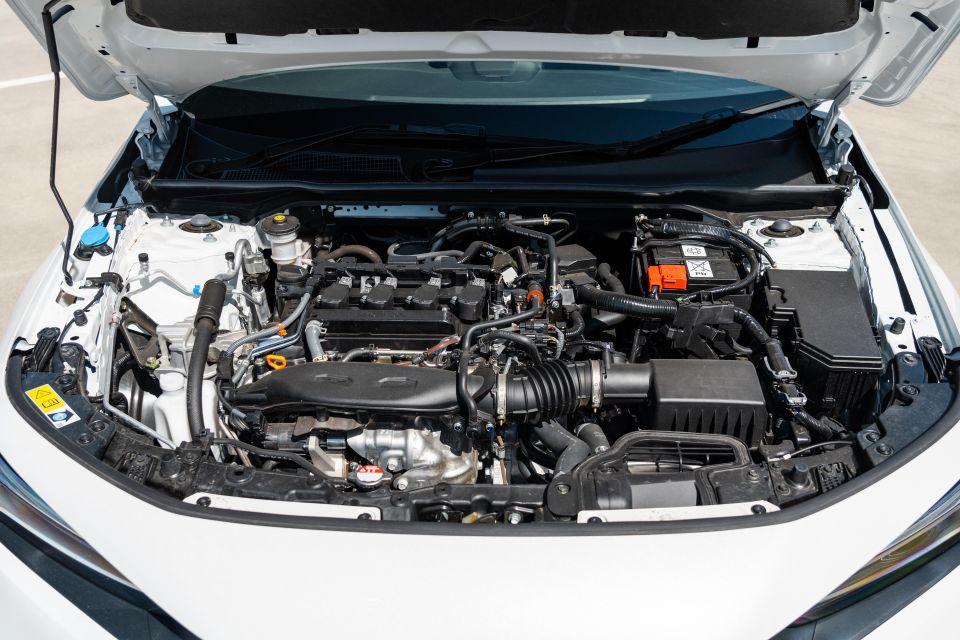
Power in the Honda Civic comes from a 1.5-litre four-cylinder turbocharged petrol engine with 131kW of power and 240Nm of torque.
It’s mated with a CVT as standard. The 0-100km/h sprint takes around 7.5 seconds, according to Honda.
The Civic uses a claimed 6.3 litres per 100km on the combined cycle. It has a 47-litre fuel tank and is fitted with idle stop/start technology. It drinks 91 RON regular unleaded.
We saw fuel economy of 6.5 litres per 100km on a combined city and highway loop.
Volkswagen Golf
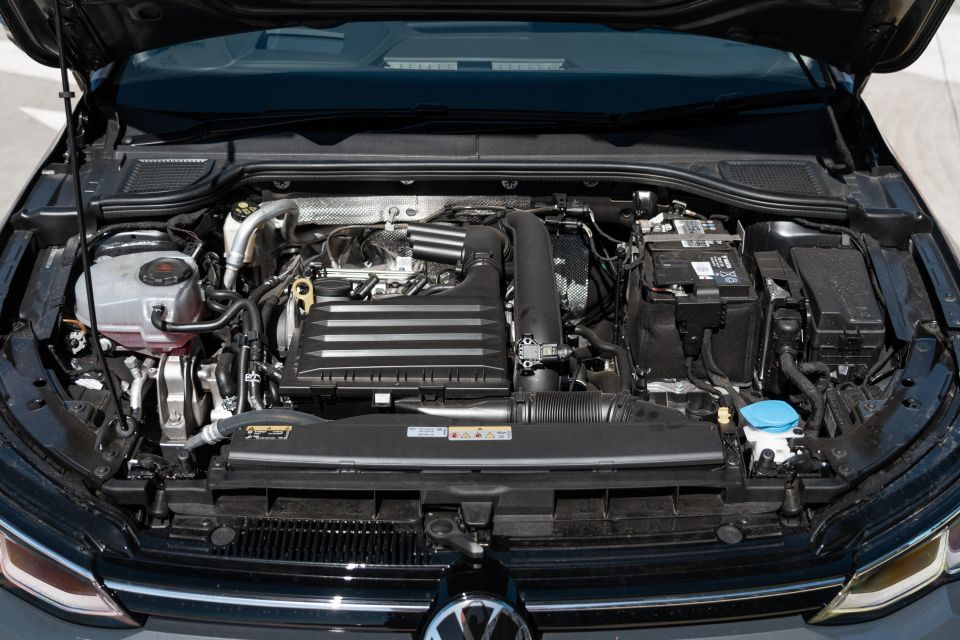
Power in the Volkswagen Golf comes from a 1.4-litre four-cylinder turbocharged petrol engine with 110kW of power and 250Nm of torque.
It’s mated with an eight-speed automatic transmission as standard. The 0-100km/h sprint takes a claimed 8.5 seconds.
The Golf uses a claimed 5.8 litres per 100km on the combined cycle. It has a 50-litre fuel tank and is fitted with idle stop/start technology. It drinks minimum 95 RON regular unleaded.
We saw 5.7 litres per 100km on a combined city and highway loop.
Mazda 3
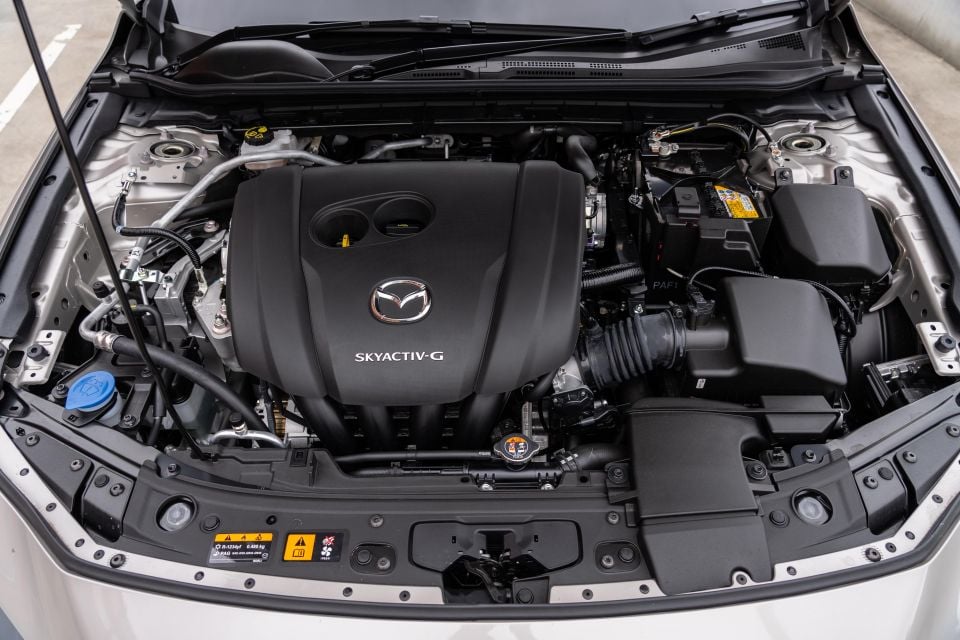
Power in the Mazda 3 G25 comes from a 2.5-litre naturally-aspirated four-cylinder petrol engine with 138kW of power and 242Nm of torque.
It’s mated with a choice of six-speed automatic and six-speed manual transmission; our tester was the automatic. Mazda doesn’t have a claimed listed for the 100km/h sprint.
The 3 uses a claimed 6.6 litres per 100km on the combined cycle. It has a 51-litre fuel tank and is fitted with idle stop/start technology. It drinks 91 RON regular unleaded.
We saw fuel economy of 7.4 litres per 100km on a combined city and highway loop.
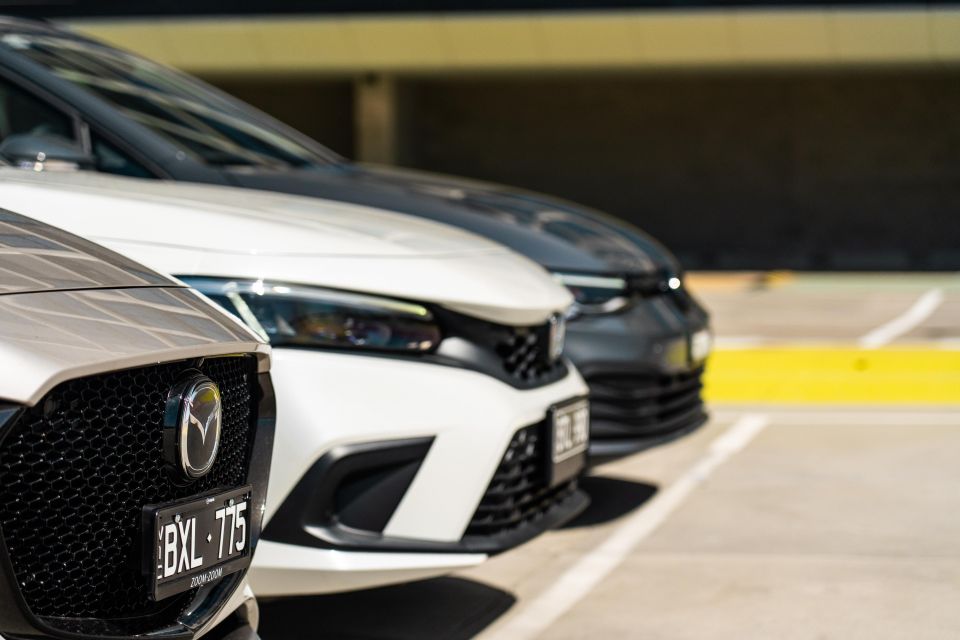
| Civic | Golf | Mazda 3 | |
|---|---|---|---|
| Displacement | 1.5L | 1.4L | 2.5L |
| Turbo | Yes | Yes | No |
| Cylinders | Four | Four | Four |
| Power | 131kW | 110kW | 138kW |
| Torque | 240Nm | 250Nm | 242Nm |
| Driven wheels | Front | Front | Front |
| Transmission | CVT | 8AT | 6AT |
| Economy (claim) | 6.3L/100km | 5.8L/100km | 6.6L/100km |
| Economy (tested) | 6.5L/100km | 5.7L/100km | 7.4L/100km |
| Fuel tank | 47L (91 RON) | 50L (95 RON) | 51L (91 RON) |
| Tare mass | 1358kg | 1304kg | 1340kg |
Honda Civic
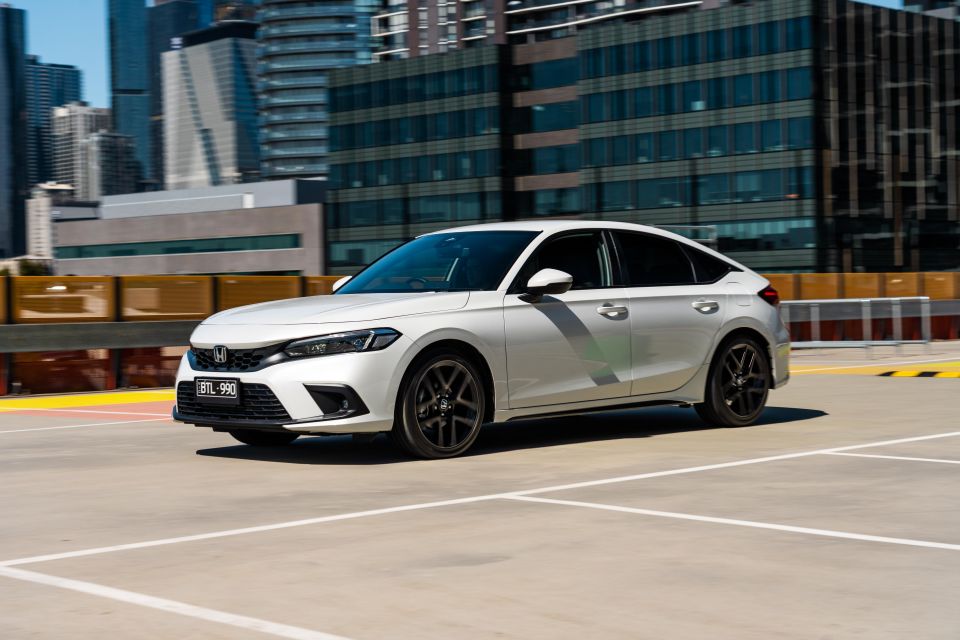
Honda has taken what was good about the last Civic and applied a few extra coats of polish.
For starters, the 1.5-litre engine is a smoother, quieter companion than before, and it’s mated to a much smarter CVT. Putting your foot down in the last Civic would see the engine hover around the 4000rpm mark, droning all the way.
Bury the accelerator in the 2022 car and the transmission does an impressive job impersonating a conventional auto, hanging onto a virtual gear through to redline and delivering a passable take on an upshift.
It’s never noisy or coarse, all of which means you can actually enjoy tapping into the turbocharged performance on offer. Although it’s down on torque slightly relative to the Golf, it feels every bit as quick in-gear, and the extra power on tap means it feels more determined at the top end.

When you aren’t in a hurry, the engine and transmission are impressively refined. The automatic start/stop is almost imperceptible, and the linear throttle makes it easy to be smooth off the mark.
Riding on 18-inch alloy wheels wrapped in slim-ish rubber, the Civic was never going to be a magic carpet. It rides well though, combining firm body control with enough compliance to keep sharp bumps from crashing into the cabin.
It sits somewhere between its two rivals in how it’s tuned, with a more tied-down and sporty feeling than you get in the Golf without stretching quite as far as Mazda.
There’s a sporty edge to the way it’s tuned, backed by quick, fluid steering. Not only does the car have a 35mm longer wheelbase than the last model, it has a 12mm wider rear track. There’s no cost-saving torsion beam rear suspension; the Civic has a more sophisticated multi-link setup.
It feels rock solid at 100km/h, and the latest Honda Sensing driver assists are well calibrated.

The adaptive cruise doesn’t jump at shadows and slows naturally when someone pulls in front of you, while the lane-keep assist is confident without feeling like it wants to wrestle the wheel from your hands.
Honda has finally moved on from its LaneWatch system, which means you get proper blind-spot monitoring and rear cross-traffic alert as well.
Honda says the new Civic is more aerodynamic, stiffer, and features more sound deadening than before, but there’s still a lot of white noise from the tyres on what look like decent road surfaces.
You can drown it out by cranking up the Bose sound system, but it’s not a trait that we struggled with in either the Golf or Mazda. It’s the main knock on the car, and undermines its premium pitch.
There’s some fun to be had slinging the VTi LX into corners. It feels reasonably light on its feet, and there’s plenty of grip from the Goodyear tyres. It’s a well sorted hatch, and has more to offer keen drivers than it really needs to in classic Honda fashion.
Volkswagen Golf
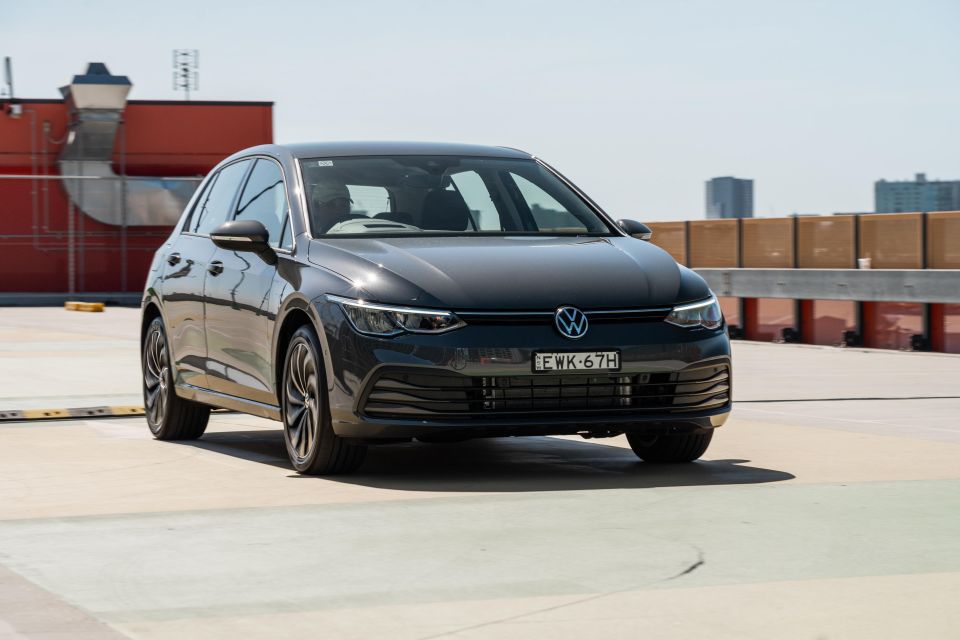
The Golf still feels like a Golf, which is to say it’s smooth, quiet, and comfortable, with a big car feeling on the open road.
The switch from a dual-clutch transmission to a more conventional torque converter means the latest Golf uses more fuel than its predecessor, but it also makes it smoother and easier to drive in the city.
Even the best dual-clutch transmissions carry some kind of learning curve, the eight-speeder in the new Golf doesn’t.
It’s smart enough to keep the 1.4-litre engine in its torque band most of the time, slurring inoffensively from gear-to-gear at a cruise. The extra ratios on offer relative to the Mazda, along with the torque on tap, mean it spends most of its time humming along between 1500 and 3000rpm.
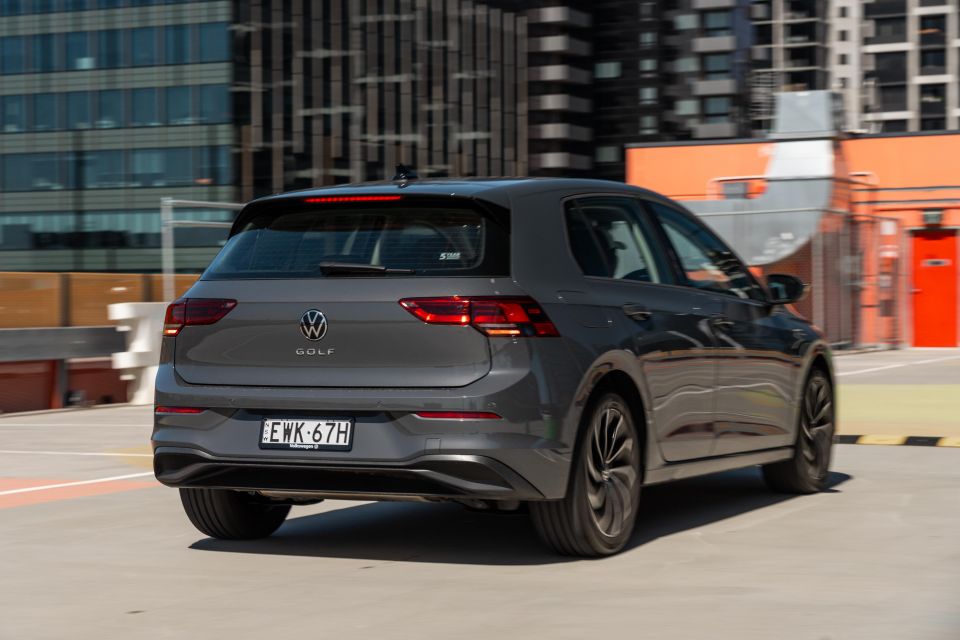
Anyone hopping out of an old Golf with its DSG transmission will notice the new torque converter isn’t as snappy on the move. It doesn’t downshift as sharply as the older transmission when you take charge with the paddles, either.
Auto start/stop works smoothly, but it’s a shame the Golf no longer has auto brake hold. Both its rivals allow you to take your foot off the brake at long traffic lights; the Golf doesn’t.
The buttery smooth power delivery and torquey mid-range mean you never really need to work the Golf hard around town, as is the case in the Honda.
Ride comfort is a Golf Life specialty alongside its sportier rivals. It floats along in the city, effortlessly dismissing pimply surfaces, and has a longer-legged feel on the open road.
With light steering and the best all-round visibility of our trio, it’s a cinch to slot into tight carparks.

Volkswagen’s active driver assists (IQ.Drive) are all smartly tuned. The adaptive cruise control smoothly maintains a gap to the car in front, and the lane-centring feels in command of the car without trying to rip the wheel out of your hands.
It’s impressively refined at a cruise, although the Mazda still has it covered if you’re after the quietest car of our trio.
Like the Honda, the Golf has a more sophisticated multi-link rear suspension which no doubt contributes to the car’s planted, neutral feeling from behind the wheel. Of the three cars here it’s the least sporty.
Flick it into a corner and the nose just goes where you want it to, with very little in the way of understeer or lift-off oversteer. It majors on low-fuss stability rather than outright thrills, although it’ll still put a smile on your face.
Mazda 3
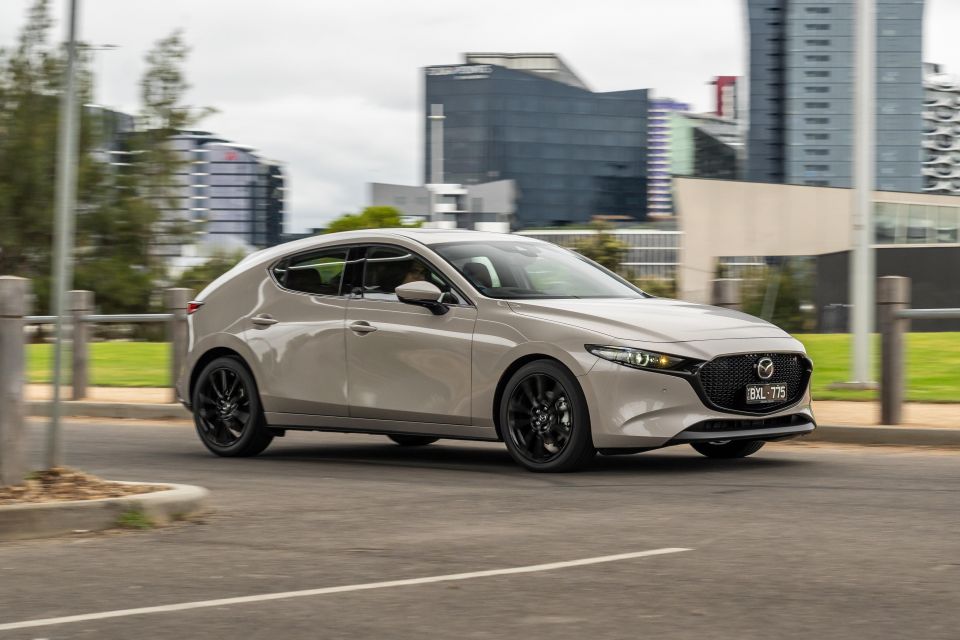
Of the three cars here, the Mazda manages to be the sportiest… and the slowest.
Its naturally-aspirated engine has numbers not far from what’s on offer in the Honda and Mazda, but in the real world you need to work it harder to extract its performance.
Rather than an effortless surge of low-down torque like you get in the Mazda and Honda, the G25 engine does its best work higher in the rev range.
It has enough punch in reserve to mooch around with traffic, but ask it to overtake and the six-speed automatic needs to kick down one or two gears to get the engine singing before the 3 really gets moving.
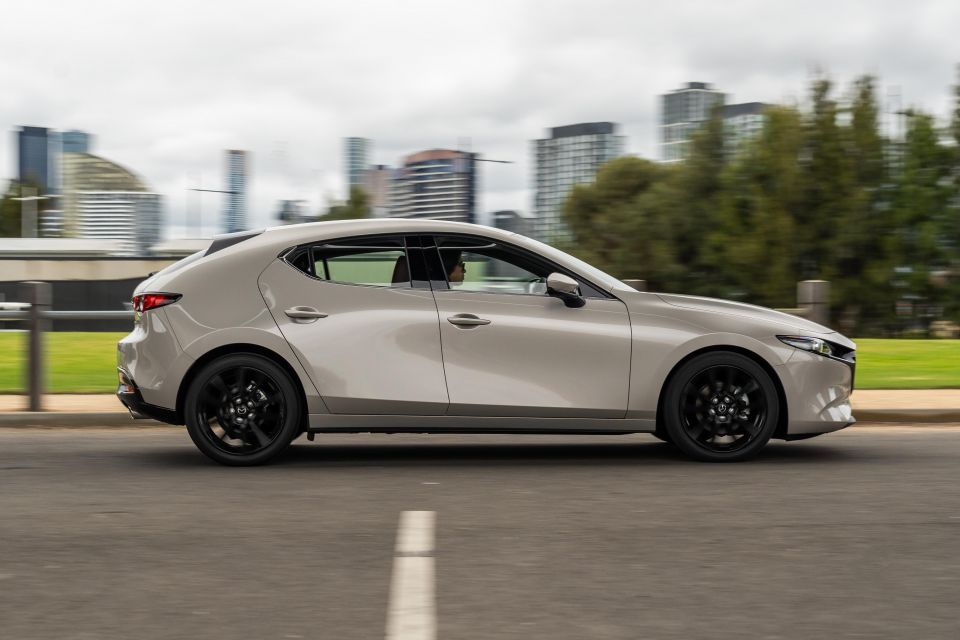
It feels a bit coarse alongside the Civic and Golf when you do push it, and the fact it’s working hard undermines its premium bent in this company.
Where it does excel is when it comes to simplicity. If you’re hopping out of an previous-generation Mazda, there’s not really much to learn about how the new car drives.
The lack of a turbocharged shove in the back means throttle response is linear, and the six-speed auto is more natural than the CVT in the Civic, even though Honda has done a good job making it mimic a torque converter.
The rest of the driving experience in the Mazda 3 is excellent. At city speeds it does an excellent job smoothing out potholes and speed bumps, and the linear steering makes it an easy car to thread through city streets. It has the firmest ride of our trio, but still is compliant enough to keep ugly road surfaces at bay.
The blind-spot monitor and surround-view cameras do a good job covering for the significant blind-spot that is the C-pillar, but they can’t entirely make up for it. Visibility has been sacrificed at the altar of style here, which does make it tricky to, say, merge from a slip lane when you need to look over your shoulder.
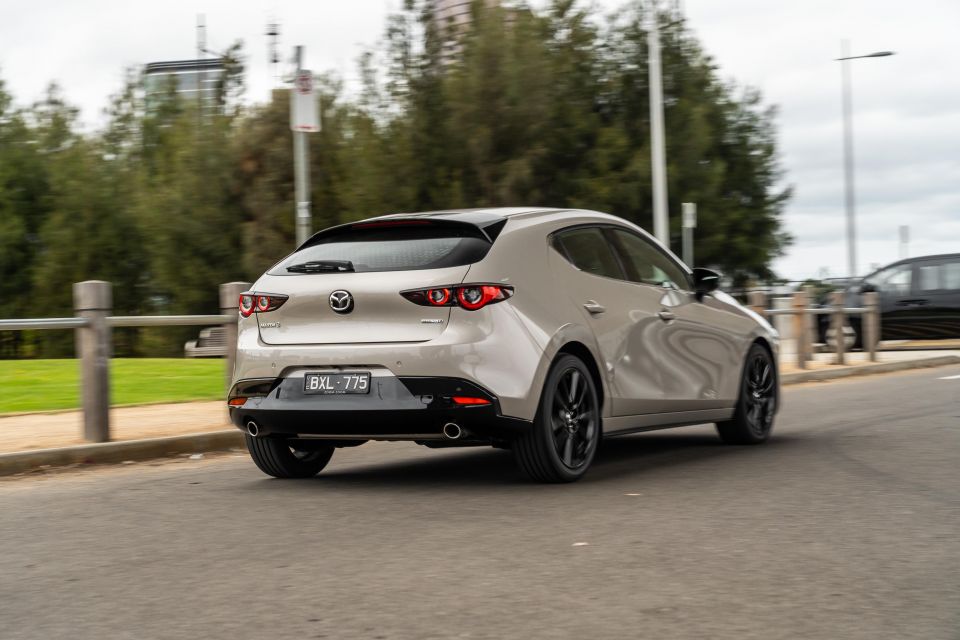
It’s noticeably harder to see out of than either of its rivals; especially the Golf with its relatively upright window line.
At highway speeds, the thing that stands about the Mazda 3 is refinement. It’s impressively hushed, even on average Australian country roads, and the engine settles down nicely at a cruise.
Hills, overtakes, or changing limits force a downshift though, which is worth bearing in mind if you spend lots of time in the great outdoors. Regardless, it’s the most refined member of our trio.
Mazda’s driver assist systems are smartly calibrated. The adaptive cruise control system keeps a consistent gap to the car in front, and the lane-keep assist will push you back if you drift too close to the white lines without getting too hands on.
Honda Civic
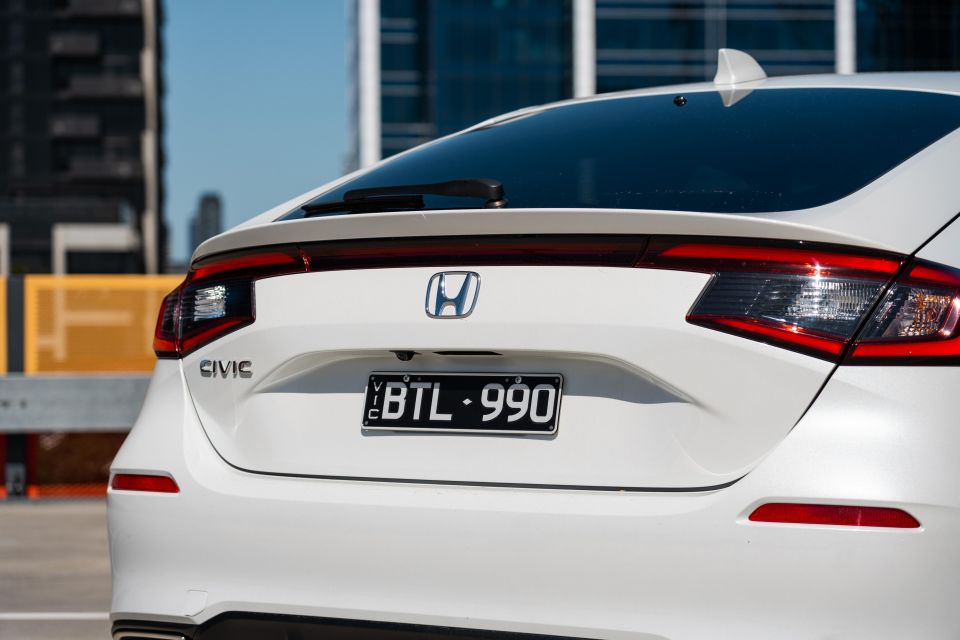
The Honda range is backed by a five-year, unlimited-kilometre warranty.
Maintenance or required every 12 months or 10,000 kilometres. Honda Australia caps the price of the first five services at $199 a pop – the cheapest here, but still $74 per year more expensive than the $125 deal Honda launched its agency model with.
Volkswagen Golf

The Volkswagen range is backed by a five-year, unlimited-kilometre warranty.
Maintenance is required every 12 months or 15,000 kilometres. Volkswagen Australia offers three- and five-year service packs for $1100 and $1900 respectively.
Mazda 3
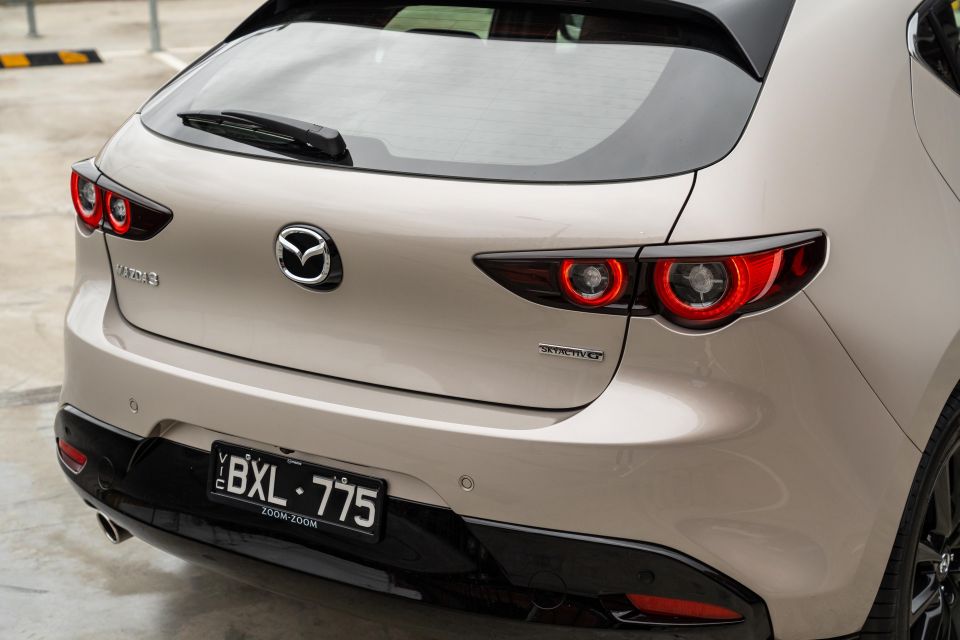
The Mazda range is backed by a five-year, unlimited-kilometre warranty.
Maintenance or required every 12 months or 10,000 kilometres. The first five services cost a combined $1700 using the brand’s capped-price service plan.
Honda copped a hiding for the way it’s priced the new Civic in Australia when it launched.
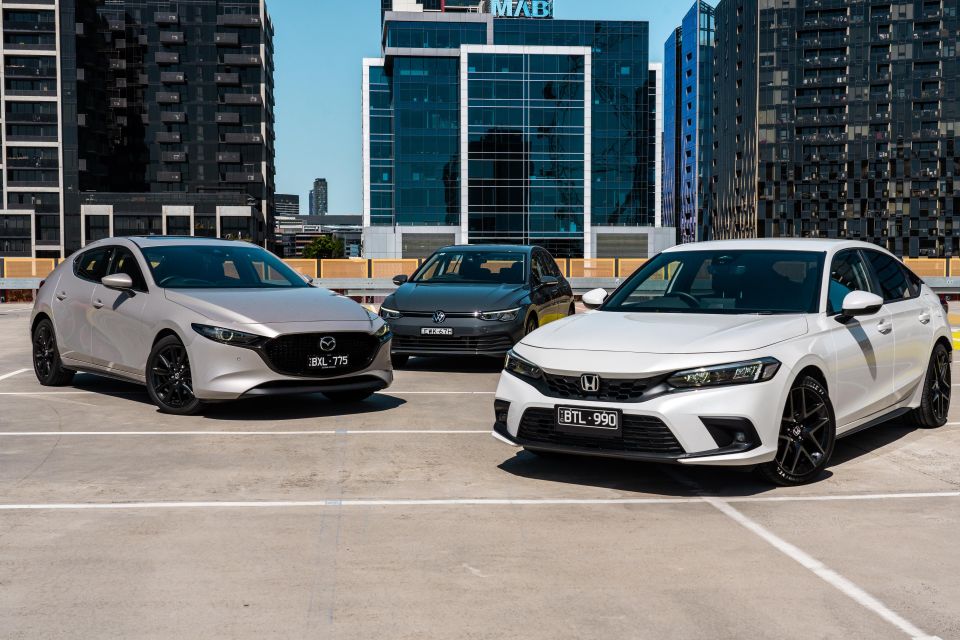
We’d still love to see an entry-level model around the $40,000 mark to help buyers on a budget get behind the wheel, but it’s unquestionably the pick of the high-spec trio here.
It combines the strengths of its rivals with aplomb, managing to combine a more premium and polished interior than that of the Golf with a driving experience that, while maybe not quite as fun as the 3, comes close to matching it.
Throw in the fact it’s bigger than both inside, is the cheapest to service, and possesses the most user-friendly suite of technology, and you’ve got a clear winner.
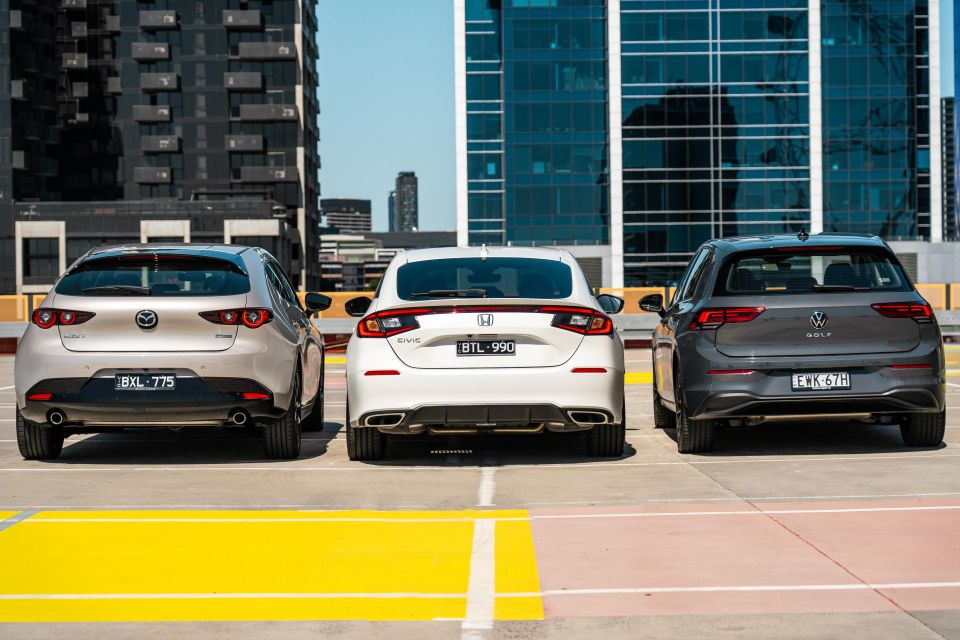
In second place is the Mazda 3. It’s not quite the all-rounder the Honda is, but it makes up for that by offering a unique interior and a sharper starting price.
Mazda head office we’re begging, please bring the turbo model to Australia. The G25 feels outgunned in this company, which undermines the whole sports-luxury combination the Astina is trying to deliver.
Finally, the Golf. It feels like a mid-range car (at best) alongside these two, but it’s not priced like one anymore.
From the slightly bland interior with its slightly too fiddly technology, to a drive that’s typically polished but lacks the sparkle on offer in the other two, it’s not the standard setter it once was.

Click the images for the full gallery
MORE: Everything Honda Civic MORE: Everything Mazda 3 MORE: Everything Volkswagen Golf
Share your thoughts with us in the comments below!
Scott Collie is an automotive journalist based in Melbourne, Australia. Scott studied journalism at RMIT University and, after a lifelong obsession with everything automotive, started covering the car industry shortly afterwards. He has a passion for travel, and is an avid Melbourne Demons supporter.
Share your thoughts and write a review of a car you own and get featured on CarExpert.


Max Davies
25 Minutes Ago


Damion Smy
9 Hours Ago
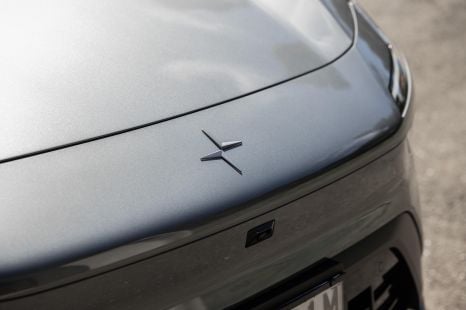

Damion Smy
9 Hours Ago


Damion Smy
11 Hours Ago
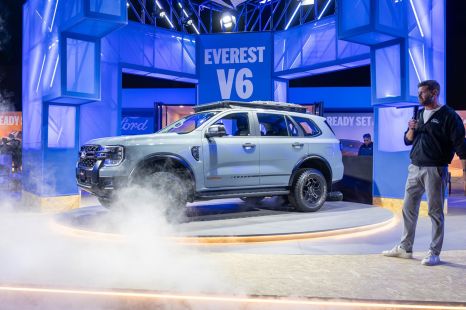

Damion Smy
13 Hours Ago


CarExpert.com.au
15 Hours Ago